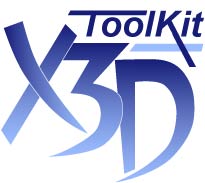
X3DToolKit features





- simply use the provided applications to visualize or process X3D models
- load and render static X3D models in OpenGL
- load and traverse the scene graph in order to edit it or simply extract informations
- easily extend the X3D language and use the new nodes in the two first use cases
- the X3D scene graph providing a simple translation of the file into a more usable data structure
- the GL scene graph based upon nodes specialized in rendering
- the MESH scene graph providing fully customizable template winged-edge structures
The provided applications are:
- X3DViewer: fast viewer of static X3D models
- X3DMeshEditor: editor of X3D models, specialized in model cleaning
- X3DStats: application printing statistics of the models (number of faces, vertices, edges...)
- X3DWorldCoordTranslator: translates the coordinates in world coordinates
The toolkit is entirely programmed in standard C++, a subtle use of templates avoids the use of macros.